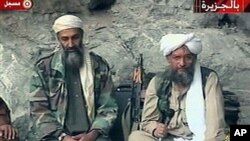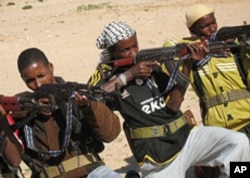Osama bin Laden’s second-in-command has taken the helm of al-Qaida, following what many call a “corporate succession plan” charted out by the terrorist group’s late leader. This plan illustrates bin Laden’s business sense that he picked up long before he was the face of jihad, while working for his Saudi family's multi-billion dollar construction company. His knack for business has been critical to al-Qaida's growth, but it is also proving to be a vulnerability.
|
Al-Qaida Emir
|
Al-Qaida runs like any other business. It keeps financial records with trails of receipts, often scribbled on notebook paper. Even arguments over printer toner cartridges are tracked. The hiring process is thorough, with a questionnaire asking recruits for personal references, previous jihad experience and whether they are exiled from their home country. If a candidate is hired, al-Qaida's bylaws neatly define their top operatives' job descriptions.
These rare details of al-Qaida's inner-workings are outlined in a series of documents from the U.S. Defense Department's Harmony Database. U.S. forces uncovered the files in Iraq, Afghanistan and other battlefields over the past decade.
Business savvy
Bruce Hoffman, a terrorism expert at Georgetown University in Washington, said bin Laden's corporate know-how defined his brand.
"I think it's his personal stamp and personal approach. And don’t forget this is what catapulted al-Qaida to prominence and certainly enabled it to become the preeminent non-state threat of our era,” said Hoffman, adding that this approach is proving troublesome for bin Laden’s group.
“So I think he applied in many cases successfully the same technique from business to running the terrorist organization, but his penchant for organization and al-Qaida’s, I think, detailed record keeping is now proving to be an enormous vulnerability.”
This vulnerability was exposed when U.S. special forces killed the world's most wanted terrorist in May. The commandos confiscated troves of information from bin Laden's Pakistani compound in the raid. The intelligence added to a collection of secrets, some of which are held at the Combating Terrorism Center at West Point in New York. The Harmony documents provide anecdotes about al-Qaida's training process, operations, fighter profiles and even job benefits.
As of 2001, documents showed married fighters earning nearly six times more than single men. The fighters also received on average a week of vacation each month and funded trips abroad for medical care. Files also revealed that al-Qaida requires its suicide bombers to sign a martyrdom agreement, vowing they willingly accept the mission and will not back out.
View the timeline of Osama bin Laden Terror:
Organizational hierarchy
In the mix of documents is a lengthy draft of al-Qaida's central command. The emir, now Ayman al-Zawahri, sits on top with a deputy emir and a leadership council of five to eight members. Below that are various committees including military, security and foreign relations.
Noman Benotman learned the ins and outs of organizations like al-Qaida as the former leader of the al-Qaida-linked Libyan Islamic Fighting Group.
“It's a normal structure for any single jihad group. Al-Qaida's just a copycat," said Benotman. He has since denounced the extremist ideology and challenges his former ways as a senior analyst at the British policy and research group, Quilliam.
Benotman said organization is so important to a group’s survival that seminars are held on the topic for aspiring leaders of jihad. "They believe in changing regimes through violence. So in a sense, they are revolutionary groups. So that said, you have to build a very good structure," he said.
Noman Benotman talks about his experience with Osama bin Laden in the early days of al-Qaida:
Central Control
Bin Laden’s charisma helped attract recruits from around the world. But Jarret Brachman, the author of the book, Global Jihadism, said bin Laden never intended to create the broad-based network al-Qaida has become.
“For bin Laden, al-Qaida was always meant to be an elite, exclusive club. It was the vanguard organization that would differentiate itself from the broader, Muslim world,” he said. “I think it became, though, really the selfish creation of several individual men who wanted a cult personality and needed that external affirmation.”
But to maintain its popularity, Brachman said the core group had to “pretend to be an inclusive, broad-based organization.”
Former leader of the Libyan Islamic Fighting Group, Noman Benotman, talks about Osama bin Laden as a leader:
Recruiting
Hoffman said before the September 11, 2001 terrorist attacks in the United States, the group could draft recruits without many restrictions. "Al-Qaida pretty much had an open hand in recruitment because few people appreciated the threat they posed,” he said.
Experts estimate that during the 1990s, al-Qaida's training camps saw thousands of recruits. But Hoffman said that changed when al-Qaida made a name for itself by flying planes into New York's World Trade Center and the Pentagon in Washington. Attacks that spurred the U.S. war in Afghanistan, where bin Laden was believed to be hiding.
"Obviously after the invasion of Afghanistan in 2001, and the fighting throughout 2002, training became much more problematical,” said Hoffman. “Not least because al-Qaida had in essence created a state within a state in Afghanistan. And the numbers, I think, dramatically fell to the hundreds, if not the scores or even the tens.” Since then, Hoffman said, training has been limited to smaller and much more modest training camps.
But al-Qaida has not let that limit it. Jarret Brachman, author of Global Jihadism, said around the same time, the group learned to embrace the power of the Internet.
"For a long time, al-Qaida just viewed the Internet more as a library, a place where they could just kind of host their eulogies, their documents,” said Brachman. “But then early 2000s, they began to realize that this was an online community where people would come and interact with each other and radicalize one another and potentially even self-radicalize."
Al-Qaida posts recruitment videos on the Web. And last year, al-Qaida in Yemen launched an online magazine called Inspire, gaining the most attention for the article, Make a Bomb in the Kitchen of Your Mom.
Don Rassler, an associate at the Combating Terrorism Center at West Point, said the Internet helps make al-Qaida accessible even to those who do not pledge their allegiance. He noted one video of a Pakistani-Dane terrorist mixing explosives in his Copenhagen apartment.
"At least for someone like Hamad Khurshid, watching these videos helped to indoctrinate him, and to motivate him to want to act and to seek training, to link up with al-Qaida, and to come back after that experience to prepare for an attack,” said Rassler.
After bin Laden’s death, al-Qaida released a video of Zawahri calling on operatives to attack the West from wherever they are in the world. But even with a strong media campaign flooding the Internet, Zawahri does not have the same appeal to al-Qaida’s followers as bin Laden did.
|
Leah Farrall, author of All Things Counter Terrorism blog, discusses Zawahri's leadersip:
|
Fawaz Gerges, the director of the Middle East Center at the London School of Economics, said Zawahri is a divisive figure.
“The selection of Ayman al-Zawahri will likely bring about major defections within al-Qaida because he is not seen, he not on the same level in terms of unification,” said Gerges. “He does not garner the same respect that Osama bin Laden did.”
Will Zawahri bring change?
With Zawahri now on top, Leah Farrall, a former Australian senior counter terrorism intelligence analyst and author of the All Things Counter Terrorism blog, said it is unlikely there will be any short term structural changes for al-Qaida. But she said if there is change, it would make the group more vulnerable.
“The rules and regulations that govern how the organization functions become more important if the people in that position are shuffling through more quickly,” said Farrall. “So that’s one thing to bear in mind. And the other thing, too, is it obviously works.”
But even the best laid plans can be disrupted by unforeseen events. Events like the seizure of bin Laden's hard drives and papers, which could aid counterterrorism efforts.
|
Fawaz Gerges, Director of the Middle East Center at LSA, talks about the crises al-Qaida faces:
|
Whatever the future maybe, al-Qaida faces challenges beyond that of getting used to a new leader. Gerges said the group is also grappling with financial issues as well as the existential threat of the Arab Spring, the popular uprisings in the Middle East and North Africa.
Al-Qaida also faces the threat of the U.S.-led war on terrorism, seemingly rejuvenated by the death of bin Laden and the troves of secrets taken from his compound. Still, analyst Bruce Hoffman said al-Qaida's corporate structure will help keep the group in business.













